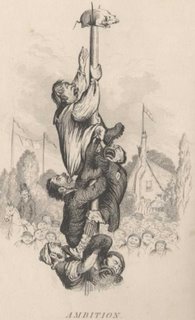 "Example:
"Example:'See George, this is the way to handle your tackle;
drop it gently into the water so; you see I make no splash;
and hold your rod steadily in this manner' "

 "Peter Simple's Foreign Adventure No. 1
"Peter Simple's Foreign Adventure No. 1'Oh vy vos I a Midshipman to be wrecked on this
desolate island. I vish I vos at home at Bloomsbury!
Oh that I had but to turn and embrace my kind,
good benevolent and much respected Grandmother' "

These obviously Victorian illustrations were made by Robert Seymour who was greatly influenced by George Cruickshank. Seymour had already established himself as a print industry caricaturist, particularly of sporting scenes, when an up and coming Charles Dickens engaged his skills for some of his early publications.
"Sketches by Seymour was published in various versions about 1836. The copy used for this PG (Project Gutenburg) edition has no date and was published by Thomas Fry, London. Some of the 90 plates note only Seymour's name, many are inscribed "Engravings by H. Wallis from sketches by Seymour." The printed book appears to be a compilation of five smaller volumes. The importance of this collection is in the engravings. The text is often mundane, is full of conundrums and puns popular in the early 1800's—and is mercifully short."
Robert Seymour didn't complete all the illustrations for Pickwick Papers - he shot himself in 1836, allegedly over the humiliation he felt at Dickens' control or evolving prominence in their collaborative project.
- Sketches by Seymour at Project Gutenburg with links to all the illustration plates - the text is a transcription.
- Robert Seymour biography and his Pickwick Papers illustrations at Victorian Web.
"Seymour was used to the imperatives of professional life, and it seems that it was essentially anxiety and overwork which eventually killed him. He was in any case of disturbed mind at the time [of his suicide] -- in later life Dickens, who had always professed great regard for him, told the story that some days before his death Seymour had asked his wife to try on a widow's cap. (Peter Ackroyd, Dickens, 182)"

No comments:
Post a Comment